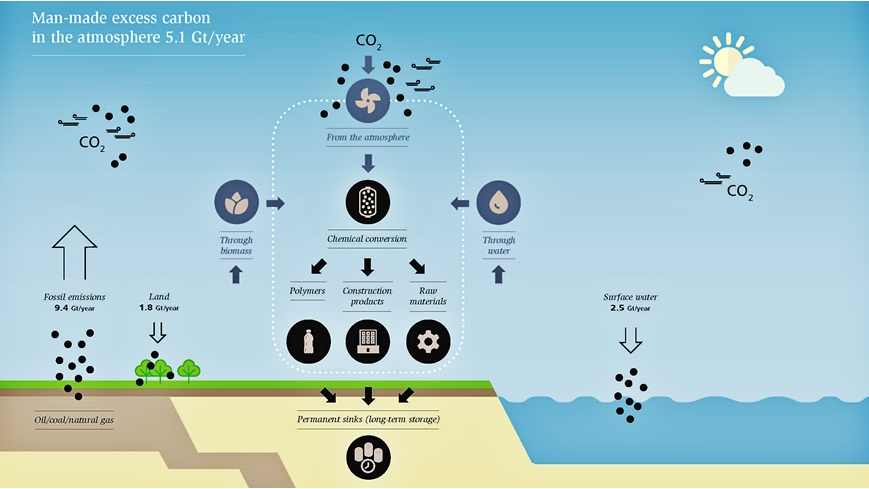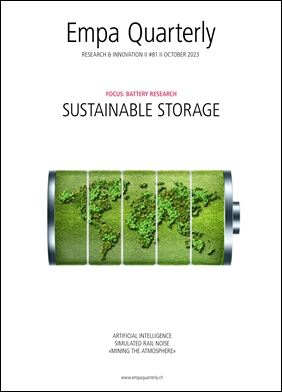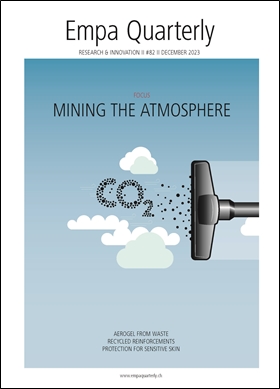Mining the atmosphere
Out of thin air
To prevent irreversible and damaging changes to the Earth's climate system, we need to remove excess (man-made) CO2 from the atmosphere. This is the goal of a large-scale research initiative at Empa: Mining the Atmosphere. To start with, Empa is hosting two events on the topic, one for professionals and one for the general public.

Fossil fuels are simply ... brilliant: easy to handle, with a high energy density, versatile, available in large quantities, hence cheap. They are the foundation of our technological progress and prosperity over the last 200 years.
But there's quite a price tag that comes with it: The Earth is heading for climate collapse. Every year, we pump around 9.4 billion tons of carbon (in the form of CO2) into the atmosphere. Natural processes, especially via vegetation and the oceans, partially compensate for this gigantic output. The bottom line, however, is an excess of around 5.1 billion tons of atmospheric carbon – every year. Since 1988, the CO2 concentration in the atmosphere has been above 350 ppm (parts per million), which is considered the limit for climate stability. If this is exceeded for a longer period of time, the Earth's climate system is in danger of collapsing – with potentially irreversible consequences.
Business as usual is therefore not an option, and even net zero can only be an interim goal. What is needed is a holistic approach that can be both technically implemented and financed. Which brings us to Mining the Atmosphere. In contrast to simply capturing CO2 and storing it in the ground – the necessary first step – the "mining" approach goes much further: The goal is to develop a completely new global economic model and the associated industrial sector that converts CO2 as the raw material of the future into valuable materials to replace conventional building materials and petrochemicals.
This approach calls for a change of perspective: Where raw materials were previously mined underground, the focus is now shifting to the atmospheric "mine". At the same time, this affects society as a whole, which is changing from a CO2-emitting society to a CO2-binding society, via the energy transition heading for net zero over the next 20 years.
That's the idea – the implementation of which is a century-long task for which countless players from research and industry will have to work together. The challenge is to remove an estimated 400 billion tons of carbon (around 1,500 billion tons of CO2) from the atmosphere.
And that is just the beginning. Then it's a matter of converting this carbon into value-adding materials, polymers, construction materials, etc. The construction sector, in particular, has a key role to play here, as concrete and other building materials could bind an enormous amount of atmospheric carbon due to their mass. After being recycled several times, the carbon-containing materials could eventually be deposited as a final carbon sink at the end of their service life.
Seminar RFA Built Environment: Mining the Atmosphere

"wissen2go": Capturing, recycling and storing CO2 to achieve net zero

Dr. Michael Hagmann
Communications
Phone +41 58 765 4592
redaktion@empa.ch

Empa Quarterly#81 Battery research
Being able to store energy is a central pillar of a sustainable energy system, since solar and wind energy are not always available in sufficient quantities when they are needed. Good batteries are indispensable for the energy transition, and thus for a more sustainable world. Empa researchers are developing batteries for different applications, from stationary energy storage to electromobility. They are also working on analyzing and recycling end-of-life batteries.
Read the latest EmpaQuarterly online or download the pdf-version.

Empa Quarterly#82 Mining the Atmosphere
To limit climate change, we need to compensate not only for future emissions, but also for historical ones. One solution would be the "atmospheric vacuum cleaner": we remove the excess CO2 from the atmosphere. But what do we do with it? Instead of extracting the carbon for polymers, medicines, fibers, fuels and the like from crude oil, we use atmospheric CO2. This is the simple – yet extremely challenging in technical terms – idea behind Empa's new research initiative, Mining the Atmosphere.
Read the EmpaQuarterly online or download the pdf-version.
-
Share

|
Going with the flow Non-toxic and scalable water-based flow batteries would be a good solution for storing renewable energy in urban areas. Empa researcher David Reber wants to improve their low energy density with clever materials design. |
|
How to work with AI Artificial intelligence is making its way into our work environments, from industrial manufacturing to research. But how can we best exploit potential synergies of man and machine, and what must we consider? |








